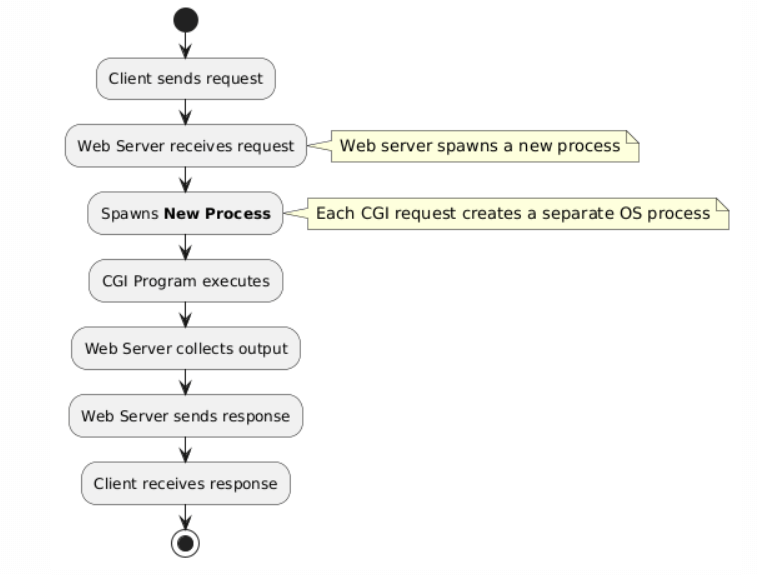Common Gateway Interface (CGI): Understanding Its Role and Limitations
Hello, aspiring web developers! We’ve discussed Servlets and their capabilities. Before Servlets revolutionized server-side programming, the Common Gateway Interface (CGI) was a foundational technology for generating dynamic web content. To truly appreciate the advancements offered by modern web technologies, it is crucial to understand CGI’s mechanisms and, more importantly, its inherent limitations.
What is the Common Gateway Interface (CGI)?
The Common Gateway Interface (CGI) is a standard protocol that defines how a web server communicates with external programs to process requests from clients and return dynamic content. In simpler terms, CGI provides a way for a web server to pass a user’s request (like data from a form submission) to an executable program (often called a CGI script or CGI program), receive the output from that program, and then send it back to the user’s web browser.
These CGI programs could be written in various programming languages, including Perl, C, Python, or shell scripts. When a web server received a request for a CGI program, it would typically:
- Launch a new process to execute the CGI program.
- Pass the request information (like form data, HTTP headers, etc.) to the program via environment variables or standard input.
- The CGI program would then perform its task (e.g., query a database, perform calculations).
- Finally, the program would send its output (often an HTML page) to the web server via standard output.
- The web server would then forward this output to the client’s browser.
The Operational Flow of a CGI Program
Understanding the step-by-step operation of a CGI program highlights its design and ultimately, its challenges:
- Client Request: First, a web browser sends an HTTP request to the web server, typically for a URL that points to a CGI program.
- Server Receives Request: Next, the web server receives this request. It recognizes that the request is for a CGI program, not a static file.
- Process Creation: Crucially, the web server then initiates a brand new operating system process to execute the CGI program. Each new request for the same CGI program results in a new, separate process being spawned.
- Information Exchange: Subsequently, the web server passes relevant request data (e.g., form field values, browser information, IP address) to the newly launched CGI process through environment variables or standard input.
- Program Execution: The CGI program performs its logic, which might involve database queries, file operations, or complex computations.
- Output Generation: Upon completion, the CGI program generates its response, usually in the form of an HTML page, which it sends back to the web server via standard output.
- Response to Client: Lastly, the web server receives this output and sends it back to the client’s browser as the HTTP response. The CGI program’s process then terminates.

Key Limitations and Drawbacks of CGI
Despite its foundational role in early dynamic web development, the Common Gateway Interface (CGI) suffered from significant limitations, especially as web applications grew in scale and complexity:
- Performance Overhead (Process Creation): The most critical drawback was the overhead associated with process creation. For every single client request, the web server had to create and destroy a new operating system process for the CGI program. This constant spawning and terminating of processes was incredibly resource-intensive and slow, leading to poor performance and scalability issues under heavy loads.
- Resource Consumption: Each separate process consumed its own memory and CPU resources. This high resource consumption quickly became a bottleneck for busy websites, limiting the number of concurrent users a server could handle efficiently.
- Platform Dependence: While CGI itself is a standard, the programs written for it often had platform-specific dependencies (e.g., shell scripts are Unix-specific, certain C libraries might not be cross-platform). This hindered portability.
- Security Concerns: Because CGI programs often had direct access to the server’s file system and could execute shell commands, poorly written CGI scripts were a frequent source of security vulnerabilities, including buffer overflows and command injection attacks.
- State Management Challenges: HTTP is a stateless protocol. CGI offered no inherent mechanism to manage a client’s state across multiple requests. Developers had to implement complex workarounds (like hidden form fields or URL rewriting) to maintain session information, which was cumbersome.
The Evolution Beyond CGI
The limitations of CGI created a clear need for more efficient and robust server-side technologies. This paved the way for advancements like Servlets, which addressed these issues by running within a single, persistent process (the Servlet container) and using threads instead of new processes for each request. Furthermore, technologies like Java Servlets provided richer APIs for handling HTTP requests, managing sessions, and interacting with enterprise resources.
Although CGI is largely superseded by modern technologies today, understanding its principles and, more importantly, its drawbacks provides valuable historical context. It highlights the challenges that led to the development of more sophisticated, performant, and secure server-side programming models that power the dynamic web we experience today.
